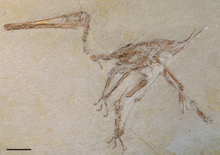Aerodactylus
| Aerodactylus | |
|---|---|

| |
| Type specimen | |
| Scientific classification | |
| Domain: | Eukaryota |
| Kingdom: | Animalia |
| Phylum: | Chordata |
| Order: | †Pterosauria |
| Suborder: | †Pterodactyloidea |
| Clade: | † Aurorazhdarchia
|
| Genus: | †Aerodactylus Vidovic & Martill, 2014 |
| Type species | |
| †Pterodactylus scolopaciceps Meyer, 1860
| |
| Species | |
| |
| Synonyms | |
| |
Aerodactylus (meaning "wind finger") is a pterosaur genus containing a single species, Aerodactylus scolopaciceps, previously regarded as a species of Pterodactylus.
The
Description


Aerodactylus is known from six fossil specimens, and though all of them are juveniles, all preserve complete skeletons.[2] The discovery of several specimens with well-preserved soft tissue traces has allowed scientists to faithfully reconstruct the life appearance of Aerodactylus.
The skulls of Aerodactylus were long and narrow with about 64 teeth which were more crowded towards the jaw tips. The teeth extended back from the tips of both jaws, and the tooth row ended before the front of the nasoantorbital fenestra, the largest opening in the skull.[4] Unlike some related species, the skull and upper jaw was curved slightly upward, not straight.[5] A small, hooked beak was present in the very tips of the jaws, with both upper and lower hook no larger than the teeth that surrounded them.[6]
The neck was long, and covered in long, bristle-like pycnofibres. A
Aerodactylus, like related pterosaurs, had a crest on its skull composed mainly of soft tissues along the top of the skull. One specimen (MCZ 1505, the counter slab of BSP 1883 XVI 1) shows a roughly triangular soft tissue crest extending upward above the posterior half of the naso-antorbital fenestra and the eye; the crest was 44 to 51 mm long (around 38 to 45% of the total length of the skull) and reached a maximum height of 9,5 mm.[4]

Bennett (2013) noted that other authors claimed that the soft tissue crest of Pterodactylus extended backward behind the skull; Bennett himself, however, didn't find any evidence for the crest extending past the back of the skull.[4] The back of the skull bore a small crest or "lappet" which pointed backward in a cone-shaped structure. The lappet was composed mainly of long, stiffened fibres twisted together in a spiral pattern inside a conical sheath of soft tissue.[7]
The wings were long, and the wing membranes appear to have lacked the furry covering of pycnofibres present in some other pterosaurs (such as Pterorhynchus and Jeholopterus). The wing membrane extended between the fingers and toes as webbing, and a uropatagium (secondary membrane between the feet and tail) was present, as well as a propatagium (membrane between the wrist and shoulder).[7] Both the finger and toe claws were covered in keratin sheaths that extended and curved into sharp hooks well beyond their bony cores.[6]
History and disputed status

In 1850
In 2018 pterosaur researcher Christopher Bennett challenged the status of Aerodactylus on several grounds: 1) that the alleged skull features are only trivially different from those seen in Pterodactylus; 2) that the specimens referred to Aerodactylus have an unusual growth regime compared to other Solnhofen pterodactyloids, suggesting that Vidovic and Martill
See also
References
- .
- ^ PMID 25337830.
- ^ S2CID 90893067.
- ^ S2CID 83722829.
- S2CID 86019483.
- ^ S2CID 130462931.
- ^ .
- ^ von Meyer (1860). Zur Fauna der Vorwelt: Reptilien aus dem lithographischen Schiefer des Jura in Deutschland und Frankreich. Frankfurt: H. Keller.
- ^ Zittel, K.A. (1883). "Über Flugsaurier aus dem lithographischen Schiefer Bayerns". Palaeontographica. 29: 47–80.
- .
